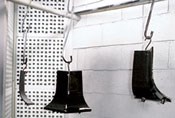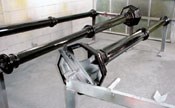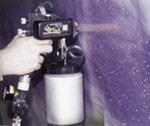High-Tech "Weaponry" for Painters
There are many things a finisher can do to reduce its coating costs and improve part quality. But, did you ever think that laser-guided spray guns would be one of them?
The average person's introduction to lasers was probably through a sci-fi book or movie such as Star Wars. In these futuristic tales, laser-guided weapons were commonplace, but laser guided weapons are no longer some half-baked pipe dream. The American public saw how precisely they could guide a missile to its target during the Gulf War. Now, even the "gunslingers" of the finishing industry have their own high-tech weaponry—laser-guided spray guns.
One user of these laser-guided spray guns is OMJC Signal Co., Waterloo, IA. In business since 1985, OMJC refurbishes used traffic signal equipment. In its early days, its primary business revolved around the traffic signals themselves. As the company matured, the product mix shifted towards the electronics that govern an intersection and the enclosures that house them. The traffic signals, lighting structures and large electrical cabinets that OMJC paints range in size from small to large and vary from cylindrical shapes to flat surfaces.
Painting Challenges
"In the past we used a fast air-dry production enamel. It was a 'federal yellow.' It contained heavy metals, but we were allowed to continue to use it because of our special application, the low volume and the fact that the paint was already in the distribution pipeline after the laws changed," said Lyle Stout, vice president and production manager at OMJC. "As our product focus changed, our customers' expectations changed. Customers wanted the luster and durability of powder coating but at a lower price. As a result we have switched to an air-dry two-part polyurethane, which allows us to continue to use our existing HVLP spray guns and other equipment. However, this new paint costs six to ten times as much as our old paint." Because of the increased cost of the new paint, it was imperative for OMJC to find a way to reduce its paint use.
OMJC was also challenged with inconsistent quality from its spray painters. Mr. Stout explained that the inconsistent quality was due to different operators with different training, tastes and experiences. "They set the gun different, used different pressures, cut the paint different, shot at differing speeds and distances, used an inconsistent overlap and so on. In essence, they are human. There would even be some variance by the same operator in the same shift," stated Mr. Stout.
Lasers to the Rescue
To overcome the challenges it was facing, OMJC began using LaserTouch, a laser-guided targeting device from Laser Touch and Technologies. According to Mr. Stout, "We had seen the LaserTouch two years ago when it was a prototype in a program at the Iowa Waste Reduction Center (IWRC) at the University of Northern Iowa. At that point, I grasped its advantages but couldn't justify the cost.
"But, we had an opportunity to send our lead painter to a training session at IWRC last fall. The training session emphasized maintaining finish quality while reducing paint use with a resulting drop in air pollution. It also emphasized consistency and discipline in painting—cutting and mixing, application techniques, monitoring wet film buildup and so on. LaserTouch was used in the training.
"They had our painter for only one shift in their facility, but he came back a different painter. He started using a viscosity cup consistently, used less paint and got a better finish. After discussing the changes with him, I concluded that the LaserTouch had been a significant aid in his training and thought it would be an aid in maintaining his new techniques as I know that old habits die hard."
After witnessing the results with one of its painters first hand, OMJC installed the laser-guided targeting system on its existing spray guns. The system is compatible with most spray guns.
How It Works
The targeting system projects two separate laser beams that appear on the part's surface. When the spray gun is held squarely to its target at the optimal distance, the two laser beams converge to form a single dot on the surface being coated. Deviations from the optimal spray gun distance or gun angle cause two separate laser dots to be produced, alerting the technician to inconsistencies in his spray technique. The manufacturer of OMJC's spray guns has a recommended gun-to-target distance to achieve maximum transfer efficiency, reducing paint use. OMJC was able to adjust the targeting system's convergence point to correspond with the gun manufacturer's recommended spray distance.
In addition to assisting the operator with gun-to-target distance and gun angle, the laser-guided targeting system may also be used to obtain a consistent 50% overlap with each stroke. A 50% overlap is essential in producing a uniform film thickness across the part and optimizing film build efficiency, which also helps reduce paint use. The targeting system also reduces the occurrence of "zebras" or striping. To obtain a 50% overlap, the operator simply guides the laser dot along the wet edge of the previous stroke.
Another feature of the targeting system allows the operator to optimize or reduce the spray pattern length for narrow parts or detailed work. With the laser beams centered in the "heart" of the spray pattern, an exact targeting system is obtained to reduce excess overspray. This ensures that the entire spray pattern hits the target area.
Operators Hit the Bull's Eye
With the addition of the laser-guided targeting device, OMJC was able to overcome the challenges it was facing, dramatically reducing paint use and improving finish quality and consistency. Before the installation of LaserTouch, one of OMJC's painters was using 1 gal of paint to finish one cabinet. However, after installation, the same painter used 1 gal of paint to finish three cabinets.
OMJC also improved the quality and consistency of the finished product due to the targeting system's ability to ensure a 50% overlap and proper gun-to-target distance. According to OMJC's foreman, finish quality was improved 30-40%.
While Mr. Stout says that the 30-40% improvement is not based on quantitative data, he could certainly see it. "Yes, we saw an improved finish with a significant reduction in paint usage. The training program that included the use of the LaserTouch plus some additional training from our paint rep on using the paint both contributed to the good finish and reduced usage that we now have. To be successful, it must be a package deal. The LaserTouch can't magically ‘heal' bad habits or ignorance, but it can aid training and reinforce good habits."
Essentially, the laser-guided targeting system has allowed OMJC to make painting more of a science and less of an art. "Large manufacturers achieve this every day. If they didn't, they would be out of business," stated Mr. Stout. "So the ultimate goal is profitability. Customer satisfaction leads to profitability. Increased employee productivity leads to profitability. Achieving the needed quality while using less material leads to profitability. Achieving those goals across all operators leads to profitability.
"But how you do all of this is difficult, especially in an environment such as ours in which the only constant from one project to the next may be our address. Simply put, you must promote constants and reduce variables. You need to be tracking variables and attempting to conform them to a set of standards. And, the LaserTouch helps remind the operator of how he should be handling his gun. If we establish guidelines for the painters, train them in using the guidelines and enforce the guidelines, the goals can be met. And, coincidentally, the employees will take more pride in their work because the guidelines show them how to be successful."
Related Content
Curing Oven Basics
Simply heating up the substrate does not cure the coating. There are many variables to consider when choosing the best cure oven for your application...
Read MoreProducts Finishing Reveals 2024 Qualifying Top Shops
PF reveals the qualifying shops in its annual Top Shops Benchmarking Survey — a program designed to offer shops insights into their overall performance in the industry.
Read MoreTTX’s Automated Conveyor Carrier System Offers Wireless, Flexible Operation
ACC system designed for reliable, consistent point-to-point movement of everything from small to heavy parts.
Read MoreZinc Phosphate: Questions and Answers
Our experts share specific questions about zinc phosphate and pretreatment
Read MoreRead Next
A ‘Clean’ Agenda Offers Unique Presentations in Chicago
The 2024 Parts Cleaning Conference, co-located with the International Manufacturing Technology Show, includes presentations by several speakers who are new to the conference and topics that have not been covered in past editions of this event.
Read MoreEducation Bringing Cleaning to Machining
Debuting new speakers and cleaning technology content during this half-day workshop co-located with IMTS 2024.
Read MoreEpisode 45: An Interview with Chandler Mancuso, MacDermid Envio Solutions
Chandler Mancuso, technical director with MacDermid Envio discusses updating your wastewater treatment system and implementing materials recycling solutions to increase efficiencies, control costs and reduce environmental impact.
Read More
.JPG;width=70;height=70;mode=crop)

























